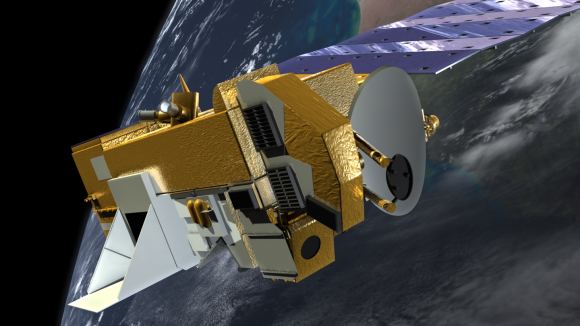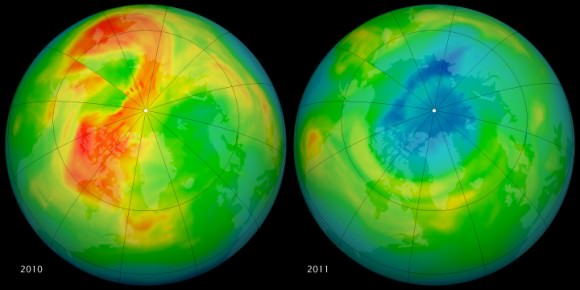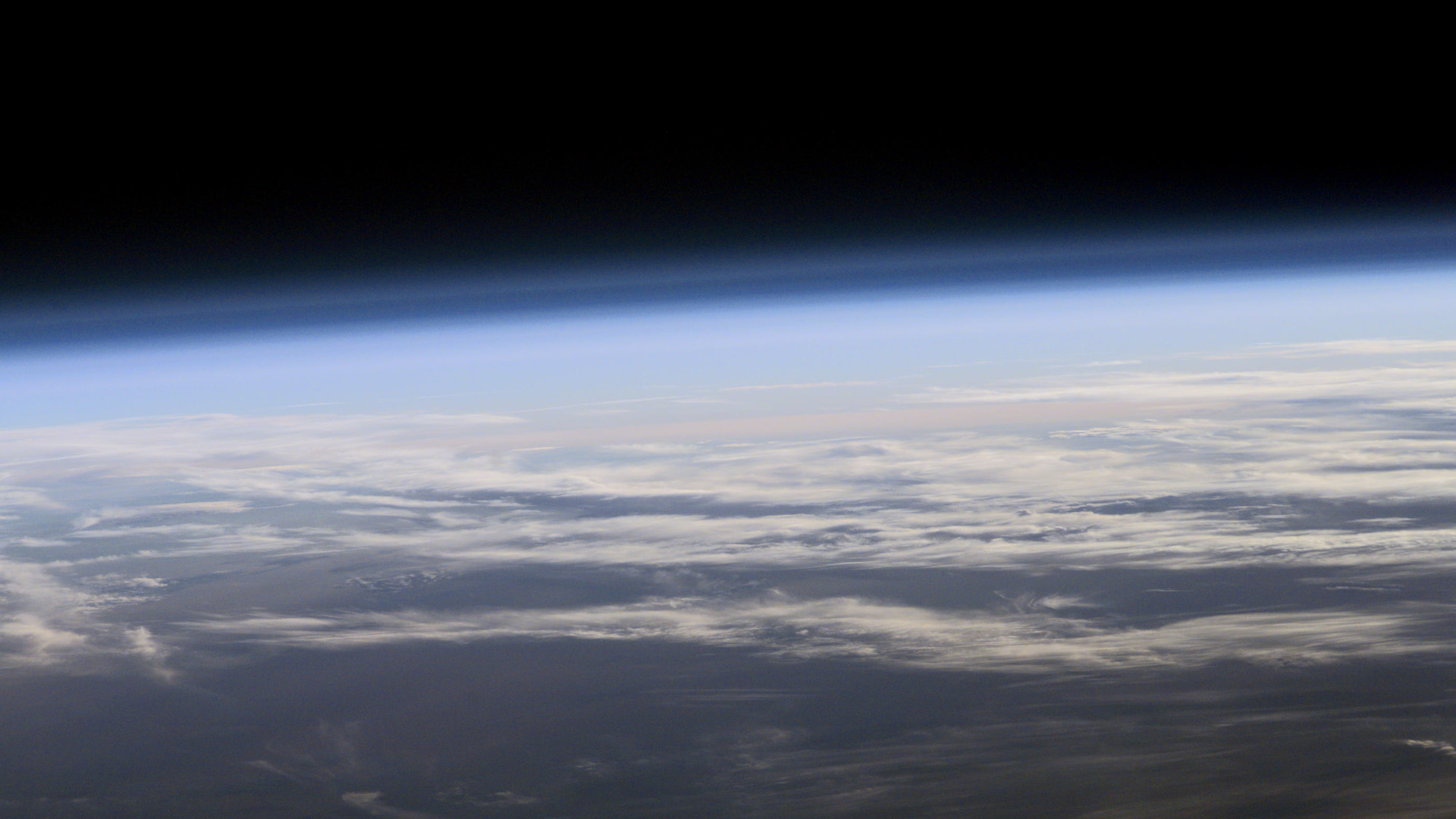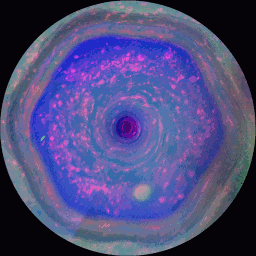The ozone layer is a integral part of what makes Earth habitable. This region of the stratosphere is responsible for absorbing the majority of the Sun’s ultraviolet radiation, thus ensuring terrestrial organisms are not irradiated. Since the 1970s, scientists became aware of a steady decline in this layer around the southern polar region, along with and a major seasonal decrease. This latter phenomena, known as the “ozone hole”, has been a major concern for decades.
Attempts to remedy this situation have focused on cutting the use of industrial chemicals, such as chlorofluorocarbons (CFCs). These efforts culminated with the signing of the Montreal Protocol in 1987, which called for the complete phasing out of ozone-depleting substances (ODSs). And according to recent study by a team of NASA scientists, the ozone hole is showing signs of significant recovery as a result.
The study, titled “Decline in Antarctic Ozone Depletion and Lower Stratospheric Chlorine Determined From Aura Microwave Limb Sounder Observations“, recently appeared in the scientific journal Geophysical Research Letters. The study was led by Susan E Strahan and co-authored by Anne R. Douglass, two research scientists with NASA Goddard’s Atmospheric Chemistry and Dynamics Laboratory.

For the sake of their study, the team consulted data from NASA’s Aura satellite, which has been monitoring the southern polar region since 2005. Having launched in 2004, the purpose of the Aura satellite was to conduct measurements of ozone, aerosols and key gases in the Earth’s atmosphere. And according to the readings it has gathered since 2005, the reductions in the use of CFCs has led to a 20% decrease in ozone depletion.
Simply put, CFCs are long-lived chemical compounds that are made up of carbon, chlorine, and fluorine. Since the latter half of the 20th century, they have been used in a number of industrial applications such as refrigeration (as Freon), in chemical aerosols (as propellants), and as solvents. Eventually, these chemicals rise into the stratosphere where they become subject to UV radiation and are broken down into chlorine atoms.
These chlorine atoms play havoc with the ozone layer, where they catalyze to form oxygen gas (O²). This activity begins around July during the Southern Hemisphere’s winter, when the Sun’s rays cause an increase in the catalyzing of CFC-derived chlorine and bromine atoms in the atmosphere. By September (i.e. spring in the southern hemisphere), the activity peaks, resulting on the “ozone hole” that scientists first noted in 1985.
In the past, statistical analysis studies have indicated that ozone depletion has increased since. However, this study – which was the first to use measurements of the chemical composition inside the ozone hole – indicated that ozone depletion is decreasing. What’s more, it indicated that the decrease is caused by the decline in CFC use.
As Susan Strahan explained in a recent NASA press release, “We see very clearly that chlorine from CFCs is going down in the ozone hole, and that less ozone depletion is occurring because of it.” To determine how ozone and other chemicals in the atmosphere have changed from year to year, scientists have relied on data from the Aura satellite’s Microwave Limb Sounder (MLS).
Unlike other instruments that rely on sunlight to obtain spectra from atmospheric gases, this instrument measures these gases respective microwave emissions. As a result, it can measure trace gases over Antarctica during a key time of the year – when the southern hemisphere is experiencing winter and weather in the stratosphere is calm and temperatures are low and stable.
The change in ozone levels from the beginning to the end of Southern Hemisphere’s winter (early July to mid-September) was computed daily using MLS measurements every year from 2005 to 2016. While these measurements indicated a decrease in ozone loss, Strahan and Douglass wanted to be certain reductions in the use of CFCs was what was responsible.
This they did by looking for telltale signs of hydrochloric acid in the MLS data, which chlorine will form by reacting with methane (but only when all available ozone is depleted). As Strahan explained:
“During this period, Antarctic temperatures are always very low, so the rate of ozone destruction depends mostly on how much chlorine there is. This is when we want to measure ozone loss… By around mid-October, all the chlorine compounds are conveniently converted into one gas, so by measuring hydrochloric acid we have a good measurement of the total chlorine.”

Another hint came in the form of nitrous oxide levels, another long-lived gas that behaves just like CFCs in much of the stratosphere – but which is not in decline like CFCs. If CFCs in the stratosphere were decreasing, it would mean that less chlorine would be present compared to nitrous oxide. By comparing MLS measurements of hydrochloric acid and nitrous oxide each year, they determined that chlorine levels were declining by about 0.8 percent per year.
As Strahan indicated, this added up to a 20% decrease from 2005 to 2016, which was consistent with what they expected. “This is very close to what our model predicts we should see for this amount of chlorine decline,” she said. “This gives us confidence that the decrease in ozone depletion through mid-September shown by MLS data is due to declining levels of chlorine coming from CFCs. But we’re not yet seeing a clear decrease in the size of the ozone hole because that’s controlled mainly by temperature after mid-September, which varies a lot from year to year.”
This process of recovery is expected to continue as CFCs gradually leave the atmosphere, though scientists anticipate that a complete recovery will take decades. This is very good news considering that the ozone hole was discovered only about three decades ago, and ozone levels began to stabilize about a decade later. Still, as Douglass explained, a full recovery is not likely to take place until the latter half of this century:
“CFCs have lifetimes from 50 to 100 years, so they linger in the atmosphere for a very long time. As far as the ozone hole being gone, we’re looking at 2060 or 2080. And even then there might still be a small hole.”
The Montreal Protocol is often touted as an example of effective international climate action, and for good reason. The Protocol was struck thirteen years after the scientific consensus on ozone depletion was reached, and just two years after the rather alarming discovery of the ozone hole. And in the years that followed, the signatories remained committed to their goals and achieved target reductions.
In the future, it is hoped that similar action can be achieved on climate change, which has been subject to delays and resistance for many years now. But as the case of the ozone hole demonstrates, international action can address a problem before it is too late.
Further Reading: NASA



